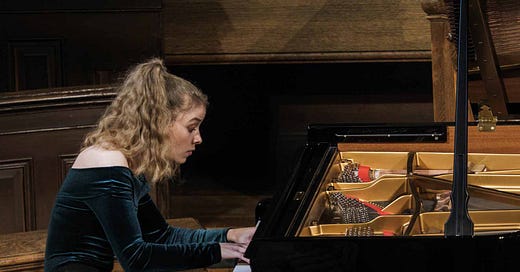Exuberance Embraces a Stylistic Straitjacket: Elisabeth Brauss at Wigmore Hall
The masterfully practised pianist enwrapped her ‘Farewell’ series in a fascinating yet restrictive template.
Elisabeth Brauss at the keyboard. Credit: Nico Rademacher/Heidelberger Frühling at www.elisabethbrauss.com
Suspense dents ease in listeners arrested by a pause: the amber stoplight calling upon contemplation. Comparable to a breath, it casts an idiosyncratic action to the ear, inviting us to intimacy. Through its vulnerable exposure we hear nervousness, anticipation; a consumptive’s victim final inhalation sealed in silent music.
Escorting her spectators to goodbyes, Elisabeth Brauss bade us four distinct adieux at Wigmore Hall last night. Bach’s Capriccio on the departure of a beloved brother opened presses delicate across diminuendi; conjuring its group of pleading friends extending vain persuasion to their leaving pal. Sweet mordents dappled in coquettish turns in the first movement, ‘Arioso. Adagio’ – prefacing a slew of left-hand key changes dealt fine aplomb in the ‘Andante’ second. Spreading pauses with the smoothness of a palette knife, Brauss painted icing on a range of delicacies executed in pristine precision. Scales across the ‘Adagissimo’ descended with the elegance of ballgown trains to tones of equal stress.
By the fifth movement, ‘Aria di Postiglione,’ Brauss’s style was affably familiar. An inimitable blueprint, it comprised swift hushes over imitations of a main motif, near-fearful gentle presses of the keys and accented first notes announcing modest sets. Solace laced its texture to remind the listeners of deftly pressing pastry bags – enveloping the ears in soothing virtuosity. Though technically scintillating, this approach did little to emote the ache of loss.
Twinkling trills were glitter in the opening movement of Beethoven’s Piano Sonata No. 26, ‘Les Adieux.’ Unveiling crisp attacks, Brauss ventured into darker shades for this depiction of Napoleon’s invasion forcing Archduke Rudolph’s flight from his Imperial Vienna. Alternating between brusque crescendi-laden chords and softened ditties, the performer showcased the three-syllable motif named after the first movement, ‘Lebewohl’, but slipped successive notes away. In ‘Abwesenheit. Andante espressivo,’ Brauss dipped certain keys so preciously, they made more sound resurfacing than being played. In contrast, crunches of crescendi cried out on select chords juxtaposed with an overtly measured left hand. Though the movement indicates a sense of stalling time, too often Brauss’s lagging tempi called to mind stuck handles on a clock.
Felicitously thrilling in ‘Das Wiedersehen’, the pianist matched speed with effortless chromatic scales – impressing with impeccable flirtatious flourishes. Higher pitches better suited this aesthetic seemingly at home in major-key coloratura.
Similarly textured chords of equidistant spaces took us to the realm of Schumann’s ‘Geistervariationen’: variations on illusions of a suicidal man. Created prior to the artist’s (thankfully non-fatal) plunge into the Rhine, the piece displays a challenge to interpreters – confining its internal terrors behind lock and key. Tranquillity quells demons vying to escape through its deliberately deceptive lyricism. In the second variation Brauss projected triplets rent by intervals identical; the third invited imitation in the left hand slender like a watermark. Sextuplets sped the third to build a spectrum psychological but the last fifth lacked ominousness, dwelling in composure.
Sinisterly whimsical, Prokofiev’s Piano Sonata No. 7 – written after the arrest and killing of his close friend and collaborator, theatre director Vsevolod Meyerhold – pits denial against surreality in terrifying switches between sharps and naturals, offbeat chords and feats of atonality. By loosening her style’s parameters, Brauss offered clashing tones and stumbling rhythms that intoned the era perfectly – excelling best of all in the first movement’s spooked staccato chords and the third’s frantic extreme pitches. Too many bars across all three remained inaptly orderly, nevertheless; suggesting horseplay rather than the doom of Stalin’s gulags.
Nostalgia targeted some tenderly conveyed diminuendo notes in Brauss’s encore, the ‘Abschied’ from Schumann’s ‘Waldszenen.’ But the work assumed a clop-like pace too comparable to what the pianist had leant the master in his ‘Geistervariationen.’
Consistent in her output, Elisabeth Brauss crafted contours technically flawless yet befitting to a narrow range of contexts in this Wigmore Hall performance. Silver platters of éclairs were often more imaginable than black stallions or arrays of lilies on a hearse. Remarkable excursions into musicality were travelled – but too often in the wrong haunts.





I attended this concert. In the first half, I thought the Bach was well-played, but the Beethoven just didn't come across well to me; not a great performance - no hiding places in such a familiar piece. The second-half however, was superb. The performance of the Schumann Geistervariationen is amongst the greatest performances I've seen live - truly beautiful playing. Then the Prokofiev was an exciting finale to the programmed works. The encore, again, by Schumann was, again, beautiful.